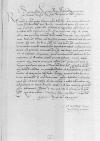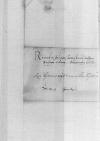⌊Sigismundus⌋ Dei gratia rex ⌊Poloniae⌋, magnus dux ⌊Lituaniae⌋, ⌊Russiae⌋, ⌊Prussiae⌋, ⌊Masoviae⌋ etc. dominus et heres
Pro certo nobis declaravit illustris dominus ⌊dux Prussiae⌋ cruciferos in hoc esse totos, ut cum exercitu, quem nunc validum in ⌊Germania⌋ conscribunt et ducibus belli designatis in ⌊Prussiam⌋ traiciant atque ibi cum alia, tum praesertim ditionem ipsius armis divexent atque oppugnent nunc, dum nos bellum cum ⌊Moschis⌋ gerimus, commodam eius rei occasionem esse rati. Ea de re, cum hic cum ⌊ipsius illustritate⌋ conferremus et rationem arcendi conatus istos improbos iniremus, visum est operae pretium, ut primarii ⌊terrarum Prussiae⌋ consiliarii, inter quos Strenuitas Tua est, et civitates aliquantas copias mercenariorum militum de suo conducant et ad omnem eventum paratos habeant. Minori enim negotio atque sumptu principiis obstari potest, quam cum mala per longas invaluere moras. Tum autem fieri potest, ut hostes tantam vigilantiam nostrorum et promptitudinem ad defendendum se videntes, territi ab incepto suo desistant. Itaque aperiet nobis hac in re Strenuitas Tua voluntatem et consilium suum, ad haec describet, existimetne opus esse, ut nova comitia ob eam causam a nobis indicantur atque instituantur in ⌊terris Prussiae⌋, nempe si id sine comitiis perfici non posse iudicaverit. Faciet Strenuitas Tua pro fide et officio suo et gratia nostra. Quae bene valeat.

